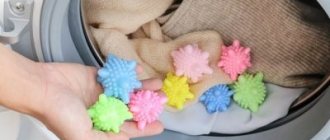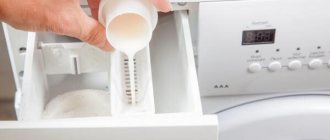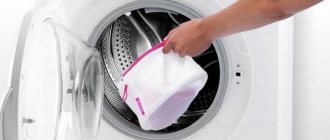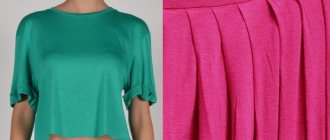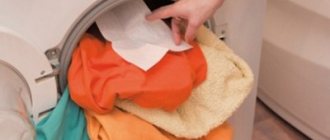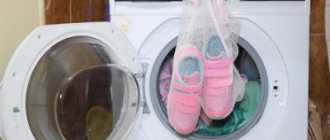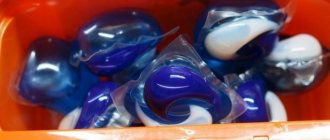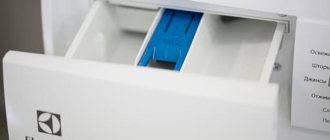Clothing made from synthetic fabrics has firmly entered the life of modern people. Our outfits have become much stronger and more resistant to wear. However, there are certain inconveniences when wearing such clothes. Static electricity appears on synthetic fabric.
It causes crackling when worn and unpleasant sensations of weak electric shocks. How to avoid these phenomena? To solve the problem, you need to use an antistatic agent for clothing.
What is it used for?
An antistatic agent is a product based on:
- alcohols,
- silicone,
- surfactant,
- other active ingredients.
The main purpose of its use is to prevent the accumulation of electrical discharges on the fabric , so that after such treatment it stops “beating with current”.
Not only are electrified items unpleasant to wear, they quickly take on a sloppy appearance even after thorough cleaning.
They stick to:
- villi,
- hairs,
- dust particles.
Antistatic agents are the solution to all these problems.
What is an antistatic agent: characteristics and properties
Static charges are created when wool fibers rub against each other. This creates a redistribution of electrons on one side of the tissue that becomes negative while positive electrons are generated on the other side of the tissue. As a result, objects in contact with surfaces “hit”, bite and attract dust. You can refuse electricity by using special means.
An antistatic agent is a chemical preparation consisting of surfactants, alcohol and water. The use of the substance creates a layer of water on the surface, reducing friction between the fibers. As a result, no electrostatic charges arise.
Kinds
There are several types of antistatic agents that can be used to treat clothing:
Alcohol sprays .
They are presented in cans that contain ethyl alcohol and other auxiliary components (propane, isobutane, fragrance). Sprays are used after washing, treating electrified items with it. The aerosol not only eliminates static electricity from clothes, but also makes the fabrics soft.However, a significant disadvantage of such products is the unpleasant odor that remains on things for some time.
- Water sprays . They contain: silicone, demineralized water, preservatives and other auxiliary components. Such compositions do not have a pronounced odor and rarely cause allergies. Use them after washing things.
- Conditioners (liquid gels). It is these antistatic agents that are used when washing electrified items.
In addition to eliminating static electricity, such products can solve a number of other problems, namely: making fabrics soft, making them easier to iron, and maintaining color saturation. The working components of antistatic air conditioners are surfactants and silicones, under the influence of which a thin film is formed on things. Charges roll along it without settling on the fibers. - Cream paste . Such compositions are used as rinsing aids for fabrics after the main wash. They are added to water, stirred, and electrified items are immersed in them for several minutes.
All types of antistatic agents are effective for eliminating static electricity from fabrics such as nylon, nylon, acrylic, lavsan, and faux fur.
3 – Prosalon, Intensis Anti-Frizz Mask
Intensis Anti-Frizz mask is a professional product for porous hair prone to electrification. Ideal for girls with curly and curly locks that are constantly tangled. Contains red algae and aloe to nourish and smooth hairs, and moisturize to eliminate static.
Application: on damp hair.
Wash off: yes.
The mask is applied like any other - onto wet hair washed with shampoo along the entire length, indented from the roots. Wash off after 5-7 minutes with plenty of water. After using the mask, do not forget to apply balm.
To enhance the effect, we also recommend taking a closer look at the Prosalon two-phase leave-in balm or fluid from the same series.
Rules of use for processing clothing
Antistatic agents should be used when washing in accordance with the recommendations given by the manufacturer. Depending on the brand, the dosage of the conditioner will vary.
Universal instructions for using antistatic agents for washing in an automatic washing machine:
place items in the drum of the washing machine;- select the desired program;
- pour the gel into a special compartment - most often it is marked with a “flower” or “star” icon;
- start the wash cycle.
Antistatic agent can be used for washing in both hot and cold water.
If manual processing of fabrics is required, then the product is added after its completion . The product is dissolved in water, the item is dipped into it, soaked for 5 minutes, then rinsed thoroughly.
What to replace it with?
Household antistatic agents can be replaced with improvised means. It turns out that many substances that everyone has in their home have the ability to remove static electricity.
They need to be added to the water at the rinsing stage after the main wash:
- Vinegar. To prepare the solution you will need 1 tbsp. l. vinegar 9% and 1 liter of water. Such a home air conditioner will not only save things from electricity, but will also help to better rinse out any remaining detergent.
- Hair conditioner + vinegar 9% + water (proportions 2:3:6) . All components are mixed and poured into rinse water.
- Salt: up to 3 tbsp. l. for 5 liters of water.
- Lemon acid . For every 10 liters of water, take 2.5 tbsp. l.
If you need to urgently remove static electricity from an item, you can use hairspray. It is applied to the wrong side of the fabric in a small amount.
Static electricity
A modern person can no longer completely abandon the presence of clothes made from synthetic fabrics in his wardrobe. Such materials are often used for lining jackets and skirts. Even some natural fabrics often contain synthetic threads.
Static electricity occurs when friction occurs between a person's body and elements of his clothing. This phenomenon most often occurs on those products that are sewn from lavsan, nylon and nylon. Hair may stick to clothes made from such fabrics. Dust settles on it more intensively, which makes such things not particularly attractive. How to deal with this? Most stores specializing in the sale of household chemicals offer customers a variety of products that eliminate this problem.
How to choose the best?
Before purchasing an antistatic agent for washing, you need to pay attention to the following points:
Compound. An antistatic agent may contain: surfactants, silicones, alcohols, acids, glycerin.
The fewer aggressive components on this list, the better. Be sure to pay attention to fragrances and fragrances. Many people prefer products that do not give off an extraneous odor.- Method of use . Conditioners are added to the washing machine immediately during washing. Things are treated with sprays and aerosols after completion.
- Secondary functions . In addition to removing static electricity, many antistatic agents have an additional effect on the fabric: they whiten or preserve the color of things, making them softer.
- What products will it be used for? There are products intended only for caring for children's things.
They contain a reduced level of surfactants and contain a minimum of fragrances, which reduces the risk of developing allergies. Children's products should not contain components such as: A-terpineol (affects the nervous system), ethanol (impairs brain function), benzyl alcohol (can cause nausea and dizziness), linalool (impairs coordination of movements). - Price. The price depends on the manufacturer of the antistatic agent. Eco-friendly products are more expensive than conventional ones.
Top 3 popular remedies
The most popular antistatic agents for washing that are in demand among consumers:
Lenor Scandinavian spring
This is an inexpensive fabric softener that has the ability to remove static electricity. This gel can only be used to care for adult clothing.
It contains:
- cationic surfactants,
- aldehyde,
- flavorings,
- linalool.
For highly electrified fabrics, you will need 140 ml of antistatic agent for every 5 kg of laundry (1 measuring cup + 1/3 cup). For ordinary things, 110 ml (1 measuring cup) is enough.
For washing diapers and undershirts, choose Lenor for children, with an adapted composition. The cost of 1 liter is about 120 rubles .
Eared nanny
This product is intended for children's things :
- does not contain dyes,
- softens linen,
- contains Aloe vera,
- passed all the necessary dermatological tests,
- does not cause allergies.
For hand washing, 1 cap (45 ml) is required for every 10 liters of water. For machine washing, take 2 measuring caps (90 ml) for every 4-5 kg of laundry. The cost of 750 ml of the product is about 80 rubles .
Synergetic
This biodegradable laundry detergent with an antistatic effect has an environmental certificate of conformity of the Russian Federation.
It contains:
- structured water,
- silver ions,
- plant complexes,
- flavorings based on natural oils,
- food coloring.
For every 5 kg of laundry you will need 30 ml of conditioner, so 2.75 liters is enough for 90 washes. Its cost is 230 rubles .
How does an antistatic agent work and why does it fight electricity?
Everyone knows what an antistatic agent is, and we will tell you how it copes with electricity
An antistatic agent is used when objects begin to “shock” due to the appearance of static electric charges on their surface. As a rule, they are formed as a result of friction. Static discharges come from things from which the charge cannot drain due to very low electrical conductivity. For example, static does not accumulate on cotton and wood because they absorb moisture from the air, allowing ions to move.
Plastic and synthetic fibers, on the contrary, repel moisture and retain a charge. An antistatic agent retains moisture and thereby increases the concentration of ions near the surface of objects. The use of antistatic agents involves applying a small amount of a substance to the surface of objects - clothing, carpets, bedspreads, curtains - in order to prevent their surfaces from sticking to each other and dust from sticking to the surfaces.
An antistatic agent usually contains polymer molecules, one end of which binds to the material, and the other, hydrophilic, picks up atmospheric moisture. The surface becomes slightly electrically conductive and gets rid of static electricity. However, the antistatic agent does not stay on the surface for very long and the treatment of objects with it has to be repeated periodically.
By the way, Popular Mechanics has a new section “Company Blogs”. If your organization wants to talk about what it does, write to us
Source
Important Tips
Before you start washing clothes with an antistatic agent, you need to familiarize yourself with the following recommendations:
- Calculate the dose accurately. If you use antistatic in excess, things will not be rinsed. They will give off a specific smell, so wearing such clothes is not comfortable. If you pour too little antistatic into the machine, it will not have the desired effect.
- People suffering from allergies are recommended to use products designed for washing children's clothes.
- If the antistatic agent contains bleach, then it is not used for washing black clothes.
- To soften fabrics, you need to choose a product containing silicone.
- After machine washing using an antistatic agent, the item does not require additional treatment. After hand washing, clothes must be rinsed.
You will find maximum useful information about washing clothes and various fabric products here.
